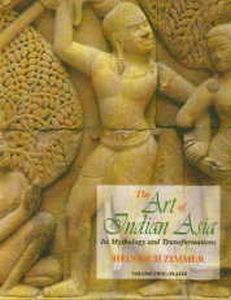
Contents: Vol. I. Text: I. The great periods of Indian art. II. The Indus Valley civilization. III. The Vedic Aryan style. IV. Mesopotamian patterns in Indian art: 1. Gods standing on animals. 2. The heaven-bird and the earth-serpent. 3. The serpent and the savior. V. Indian ideals of beauty: 1. A Maurya Mother Goddess. 2. Paleolithic Mother Goddess. 3. Indian ideals of feminine beauty. 4. The forms of the great Goddess in Indian art. 5. The South Indian bronzes. 6. The Tantric influence. 7. The Jaina style. 8. The art of Java. 9. Cambodian art. 10. Campa (Annam), and the temper of Indonesian art. 11. Bali. VI. The symbolism of the lotus: 1. The Lotus Goddess. 2. The lotus support. 3. The Bodhisattva lotus-in-hand. 4. The lotus in Burmese art. 5. The lotus in Tibet. 6. The lotus in China and Japan. 7. The Lotus Goddess of the cosmic sea—and the Palace-Temple Ankor Wat. 8. Excursus: on the contents and form of Indian sculpture. 9. The Palace-Temple Ankor Wat—and the Lotus Goddess of the cosmic sea. VII. Indian architecture: 1. The early Buddhist stupas. 2. The Buddhist Viharas, Caityas and later stupas. 3. The Buddhist pillars of victory. 4. The sacred sites of Hinduism. 5. An architecture based on wood. 6. The Great Jaina Temples. 7. The Hindu Temple, northern style. 8. The Hindu Temple, central style. 9. The Hindu temple, southern style: i. Calukya dynasty (c. 550-750). ii. Cola dynasty (c. 850—1150). iii. Pandya dynasty (c. 1100-1350). iv. Vijayanagar (c. 1350-1565). v. Madura (post 1565). vi. The architecture of the South Indian temple. 10. The Hindu Cave-Temple. 11. Borobudur and the architecture of Java. VIII. Indian sculpture: 1. The rules of the craft. 2. Bharhut. 3. The Buddhist art of Mathura, Gandhara, Amaravati and Bodhgaya. 4. Hindu sculpture. 5. The provincial forms: Ceylon; Indonesia; Further India. Appendix: A. Some notes on the art of painting: 1. Two origin legends. 2. Pala painting (c. 730-1250). 3. Gujarati (Jaina) painting (c. 1100-1600). 4. Rajput painting (c. 1550-1850). B. Maps and chronological charts: I. Chronological chart 1: Periods of Indian art. Map: 1. India. 2. Asia. 3. Southeast Asia. 2. Chronological chart 2: Provincial styles. Description of plates. Index of picture sources. General Index.
Vol. II. Plates: 614 plates.
"The present work is intended not as a handbook but as an introduction to its subject, to be read from beginning to end. Each section is preparation for the next. Chapter 1, presenting as it does a brief historical outline of the transformations of Indian art as well as a key to the symbology of the forms, can be used as a guide during the first perusal of the pictures. Fort he reader then wishing to find quickly the several portions of text referring to any specific group of monuments, a copious index has been supplied, together with textual references in the description of plates and cross-references in the footnotes. Marginal references to the plates, furthermore, accompany the text. These should make possible an easy and rapid correlation of the materials of the two volumes.
The first two groups of plates in the text volume illustrate, for the most part, the anthropological and comparative observations of the text. Included among them, however, are a few photographs that are indispensable to Dr. Zimmer’s argument but do not meet the aesthetic standard of the plates volume. On the other hand, the final cluster of text plates constitutes an independent pictorial appendix, illustrating the miniature and Rajput art of the eleventh to nineteenth centuries A.D. Dr. Zimmer’s notes on this subject had not been developed beyond preliminary jottings, and could not be incorporated in any major section of the text. But since there is actually a rather special, very delicate, lyric quality about these paintings on palm leaf and paper, which sets them apart, somewhat, from the tradition of the stone monuments, it is not inappropriate that they should be given a separate place." (jacket)
